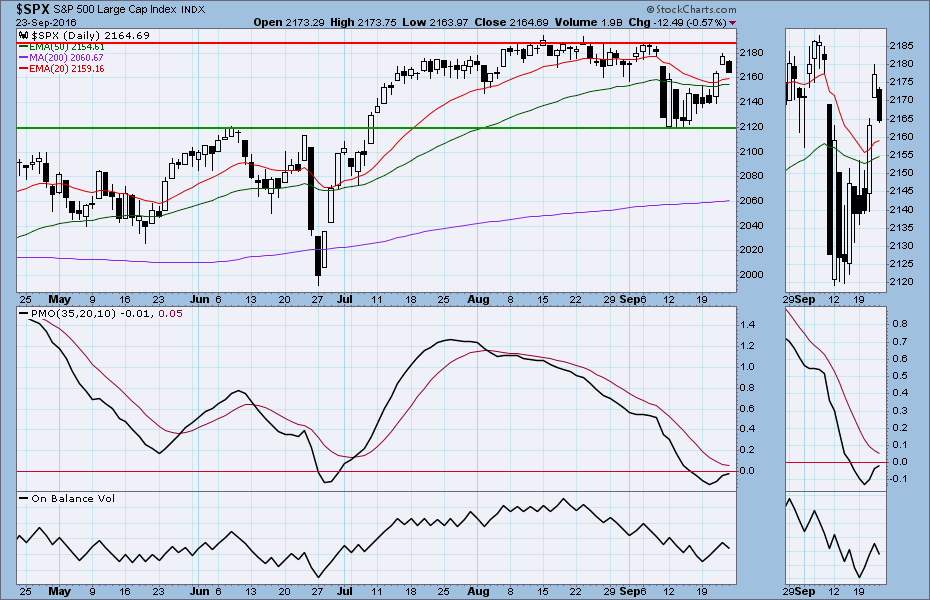SPX: A market in chains; won’t go up, and not allowed to fall
There’s a wonderful jazz tune that talks about “a love that cannot live, yet never dies.” That’s a fair description of the US equity markets these days.
The S&P 500 ($SPX), the cash index of large US companies, closed at 2164.69 last Friday, up 25.53 points for a 1.19% net weekly gain. Sounds good, right?
But this is a confusing time. The market remains high, eking out new all-time highs from time to time, but stuck in a consolidation zone that goes back to the early months of 2015, or beyond.
The brief efforts to move higher seem to have momentary success, but have no staying power and fail to ignite the kind of enthusiasm that might generate a sustained rally.
And any attempt to move the market down is met by suspicious “panic buying” that drives the market back up, sometimes to new highs that never last. There isn’t much that encourages opening new long positions; but the shorts have been getting murdered for a year or more, and many have finally capitulated.
The economic fundamentals don’t look much better. The “real economy” – to the extent financial markets care about that – is not expanding and is probably in recession now. Earnings are in a steady decline, and companies are finding it more profitable to borrow (at historically low interest rates) and use the money to buy back their own stock, rather than investing it in plant and equipment.
The large-caps look like one harsh word in the right place would start a waterfall. So treat this market with great caution. The risk on the downside looks a lot bigger than the reward on the upside, as we have been saying for several months.
Best guess: Nothing much happens before the election. They won’t let it go down, and they can’t make it go up.
This week:
The first of the debates in the US presidential election on Monday night will probably attract the largest audience for a political event in the history of the world. Depending on what happens, it may impact the markets. There is little else in the way of economic data that looks earth-shaking, but the news, if any, will assume greater importance as a result. It is the end of the month and the end of the quarter, so there will be dome choppiness in the price action.
Last week was somewhat discouraging for the Bulls. The market broke out decisively from the wedge pattern formed over the last couple of weeks, but has not recovered all of the ground lost in the second week of September. The momentum ran out, and the price ground back down.
The lack of sustained follow-through on the upside is the key issue. If we don’t see a push past last week’s high around 2180 on the SPX today or tomorrow, we will be looking for a retracement back into last week’s consolidation area 2140-2150.
If that level does not hold the price up, watch for a further drop toward 2120, where the earlier decline was halted. The short-term market looks frozen; there is not much encouragement for the Bulls, and paralyzing fear among the Bears.
Today
For the S&P500 e-mini futures (ES):
ES had a minor pullback move last Friday and managed to fill 2156, Thursday’s gap. So far the pullback was small, and took almost a day to get create a small 10.25-point trading range.
Today ES can continue going lower in the early sessions. 2156-55 will be a key zone to watch. A failure to hold up that zone could drop ES into 2141.50-43.50 to fill in some of the air pockets in the range.
2134-35.50 will be the first support zone. As long as ES holds price above that support, a bounce from it should be expected, absent any dramatic news moving the market. Sell on strong rally and buy on weakness later will be seen today.
Major support levels: 2135-33. 2123-21.50, 2112-13.50, 2103.50-01.75
Major resistance levels: 2168.50-70.50, 2175.50-78.50 , 2188-90.50, 2200-01.50
Visit www.naturus.com for more detailed analysis of gold, oil and the S&P. It’s free.
Chart: S&P500 cash index, Sept. 23, 2016. Daily chart.





